

Project Brief Introduction:
1.Product:Wet Wood Log Pellet Line
2.Capacity:2.5-3 T/Hour
3.TONY Brand 2.5-3 Ton /Hour Wet Wood Log Pellet Line Project Process
4.Main Machine: Wood Chipper,Hammer Mill, Rotary Drum Dryer,TONY Pellet MachineTYJ760-Ⅲ-160KW,Pellets Cooler,Packing Machine And Belt Conveyors
5.Total Power: About 400 kw
6.Need Area: About 640 ㎡ L: 40M W:16M H: 6.488M
Project Layout For Customer:

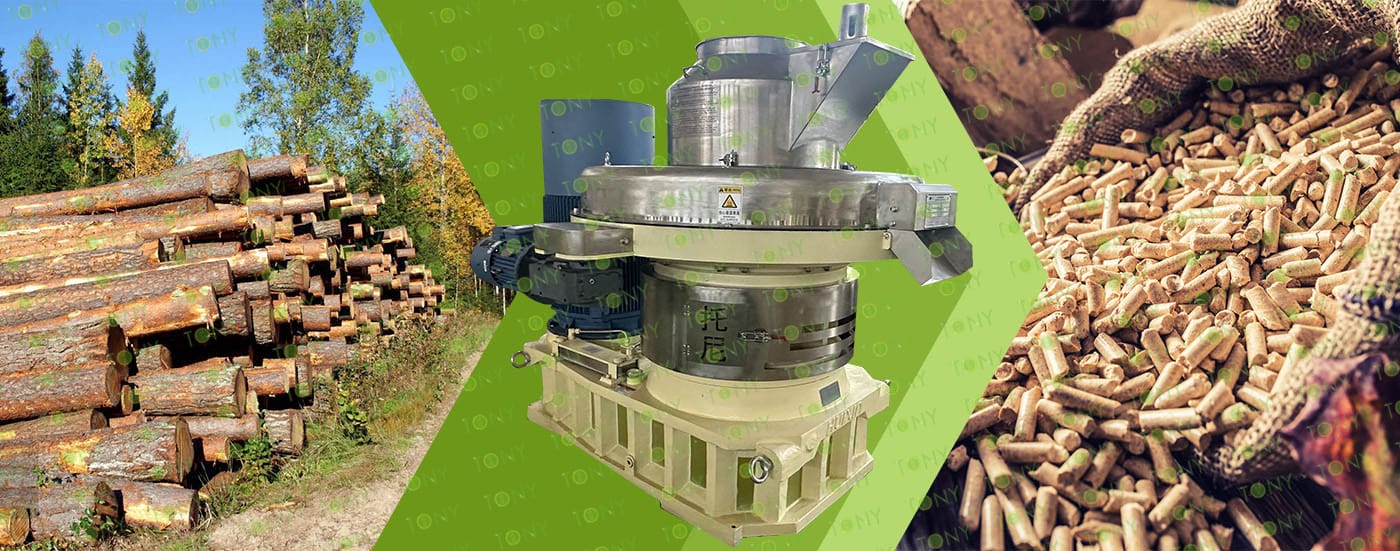
1. The working principle of wet wood log biomass pellet processing equipment
The core logic of biomass pellet processing is: crushing and refining the material → drying to control moisture content → high-pressure extrusion to densify the material and utilize lignin for natural bonding → ultimately forming high-density pellets. The entire process requires no chemical binders, relying solely on physical forces and the material's inherent composition to achieve formation. This ensures pellets' combustion properties (high density and complete combustion) while also meeting environmental standards.
2. Characteristics of wet wood log biomass pellet processing equipment
Wood pellet processing equipment (i.e., wood biomass pellet machines and supporting production lines) is designed specifically to process wood materials such as sawdust, wood chips, and branches into high-density pellets.
It is compatible with a wide range of wood materials: it can process sawdust, wood chips, shavings, wood chaff, chopped branches, and waste wood. Whether softwood (such as pine and fir) or hardwood (such as oak and birch), it can be efficiently processed after pre-treatment (crushing and pulverization).
To address fluctuations in raw material moisture: Dedicated drying equipment (such as drum dryers) can control the moisture content of the wood raw material to 10%-15% (the optimal moisture range for wood pellet production), avoiding problems such as blockage and loose pellets caused by over-moisture.
Flexible particle size processing: The accompanying pulverizer can crush the wood raw material to the size of sawdust, meeting the pellet mill's fineness requirements and ensuring uniform pellet formation.
3. Application scenarios of wet wood log biomass pellet processing equipment
Biomass pellet processing equipment (including production lines consisting of crushing equipment, drying equipment, pelletizing machines, cooling and screening equipment, and baling equipment) has a wide range of applications, with its core function being to convert agricultural and forestry waste into standardized biomass pellets.
Based on production scale, the core application scenarios of processing equipment can be categorized as follows:
Small-scale processing plants:
These are often located in rural areas, towns, or areas rich in agricultural and forestry resources. They utilize local raw materials such as straw, sawdust, and rice husks, equipped with small-scale crushing and pelletizing equipment. The pellets they produce are primarily supplied to surrounding farmers for heating and small boilers.
Medium-scale/large-scale production bases:
These are concentrated in agricultural and forestry clusters (such as wood processing parks and major grain-producing areas). These plants are equipped with fully automated production lines, with daily output reaching tens to hundreds of tons. Their products are primarily supplied to industrial enterprises, power plants, and biomass heating stations.

TONY Brand 2.5-3 Ton/Hour Wet Wood Log Pellet Manufacturing Plant can take wet wood, various types of wood - related biomass materials, such as branches, small - diameter logs, and wood shavings, with wet wood as the main raw material. After pretreatment and processing, it is solidified into high - density wood pellet fuel. This fuel is an ideal substitute for coal and oil and plays a role in energy conservation and emission reduction. At present, it has been widely used in regions rich in wood resources.
1. Capacity:2.5-3 Ton/Hour
2. Raw materials: Wet wood Log, branches, small - diameter logs, twigs, etc.
3. Moisture: Wet type, about 40%.
4. Application: All kinds of wood - based biomass materials suitable for pellet production.
Suitable customers: Green energy companies, forestry enterprises, and private wood - processing workshops that have advantages in wood raw materials.
5. Finished Pellets Markets: Large power plants, domestic heating, industrial heating, combustion heat, heating systems, boiler rooms, school canteens, foundry heat sources.

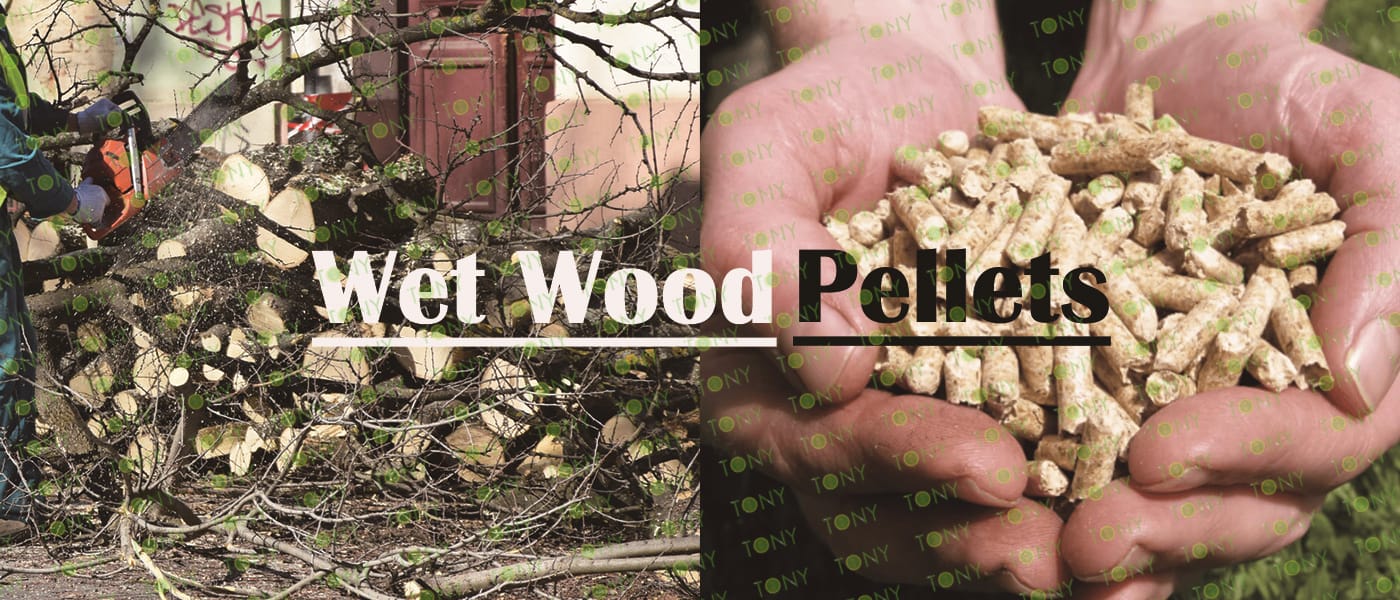
1. Project Name: Wet Wood Log Pellet Production Line
2. Raw Material: All kinds of wet wood log
3. Moisture Content of Raw Material: 40%
4. Capacity:2.5-3 tons per hour
5. Process: Crushing Process - Fine Crushing Process - Drying Process - Pelletizing Process - Cooling Process - Packing Process
6. Main Equipment: Wood Chipper TPQ216 - 55KW, Effective Hammer Mill-TFD65*75-75kw, Rotary Drum Dryer-1.8*15m, TONY Pellet Machine TYJ760 - Ⅲ - 160kw, Pellet Cooler, Small Packaging Machine and Belt Conveyors

|
How to use the TONY pellet production line to make pellets from wet wood Log? The process mainly includes the following steps and equipment: 1. Use TONY wood chipper to cut wet wood log with a diameter of less than 20 cm into wood chips 25 - 55 mm in length. 2. Use TONY effective hammer mill to crush the 25-55 mm wood chips into 8-14 mm sawdust. 3. Use TONY rotary drum dryer to dry the sawdust with a 40% moisture content down to a moisture content of 10%-15%. 4. Use TONY vertical ring die pellet machine to produce pellets with a diameter of 6-8 mm. 5. Use TONY galvanized cooler to cool the pellets from 80-90°C to 20-30°C. 6. Use TONY semi - automatic packing machine to pack the pellets into bags, each weighing 15-50 kg. For more detailed information and quotations, you can contact TONY. TONY can provide all the above - mentioned products at highly competitive prices and with excellent quality. |
|
||||||||||||||||||||||||||||||||||||||||||||||||||
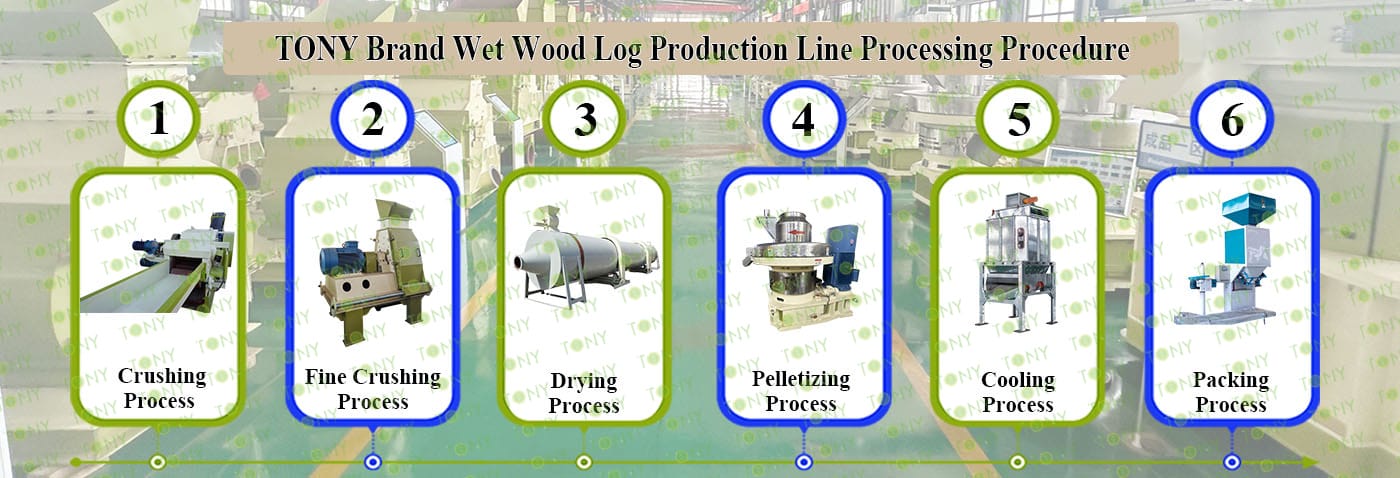
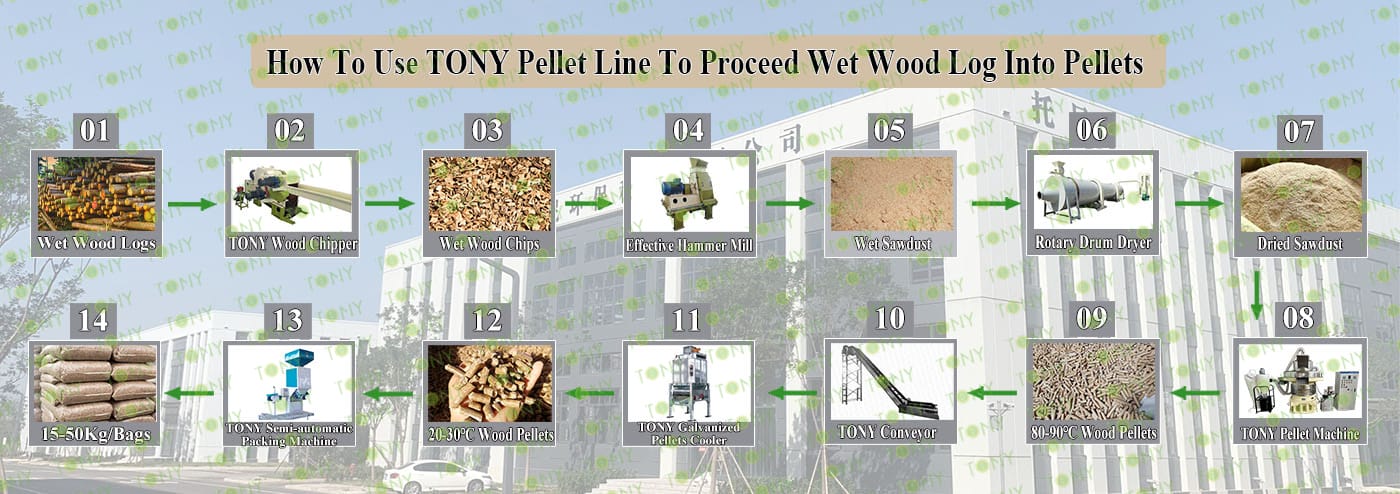

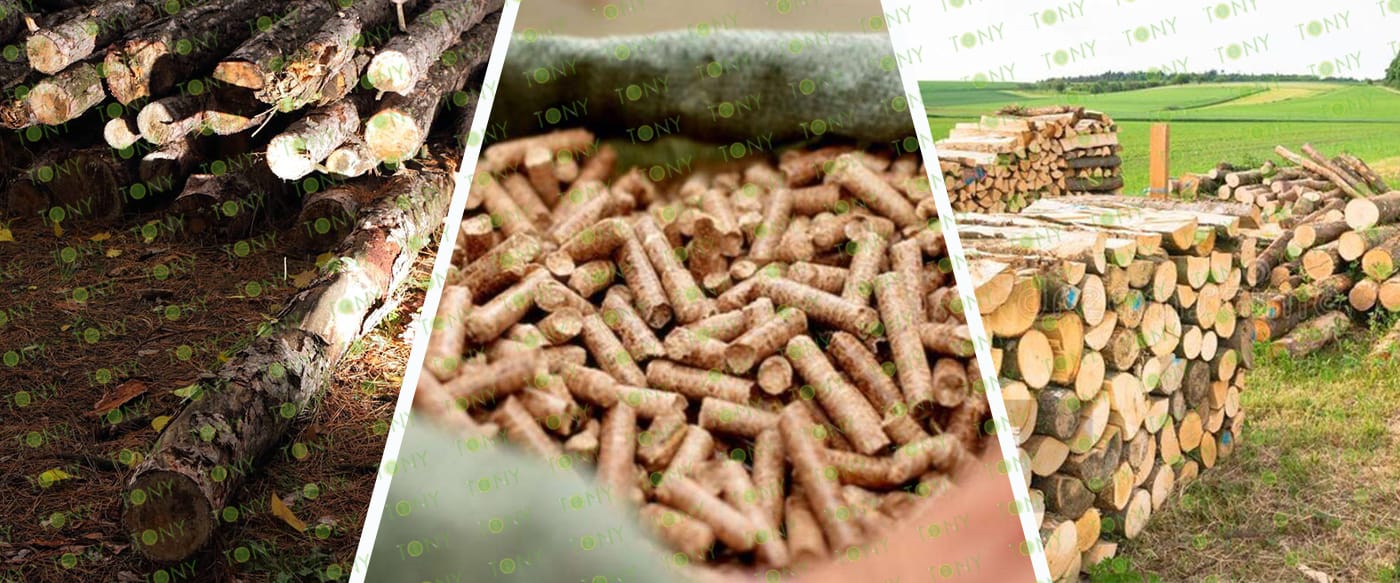

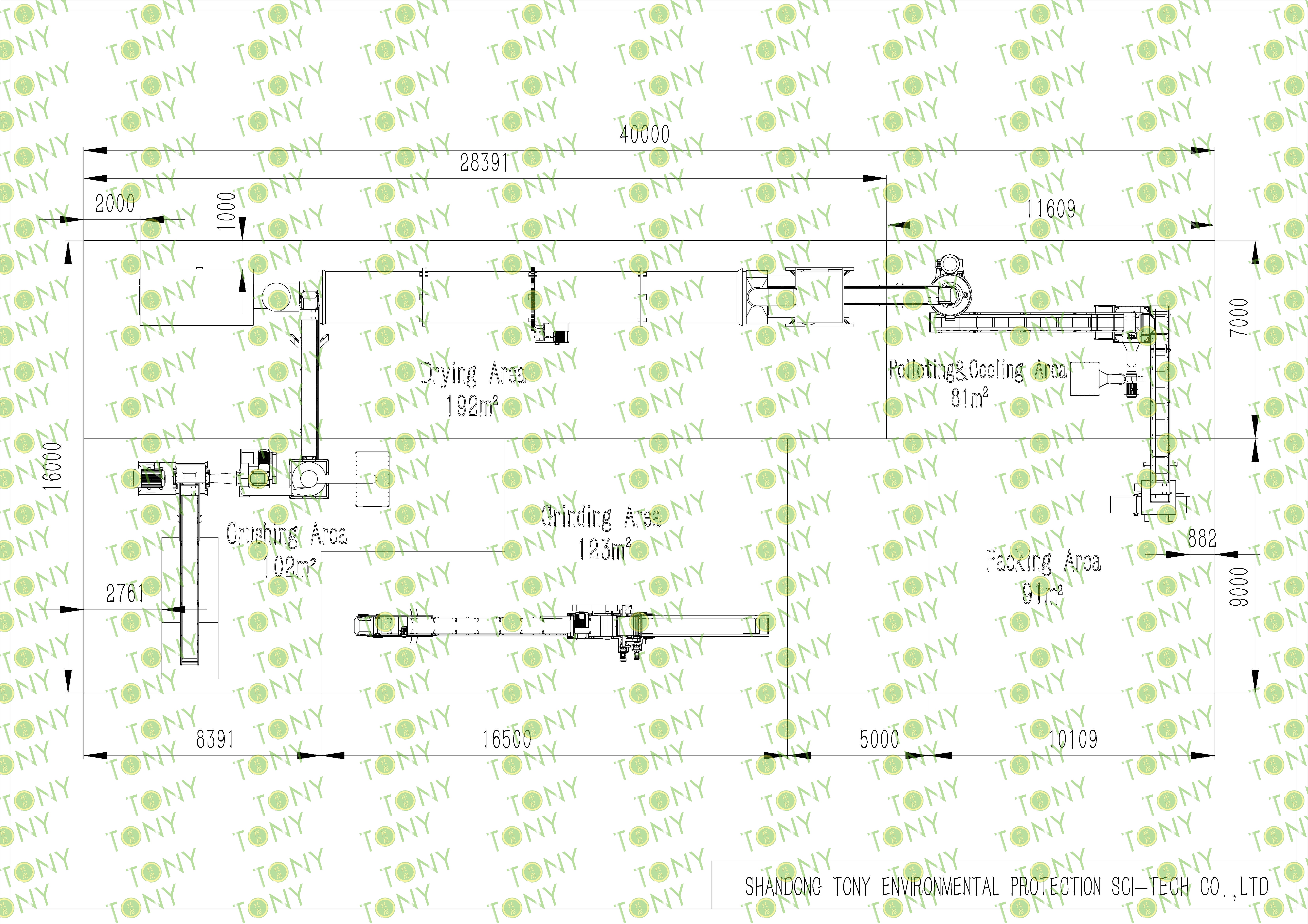
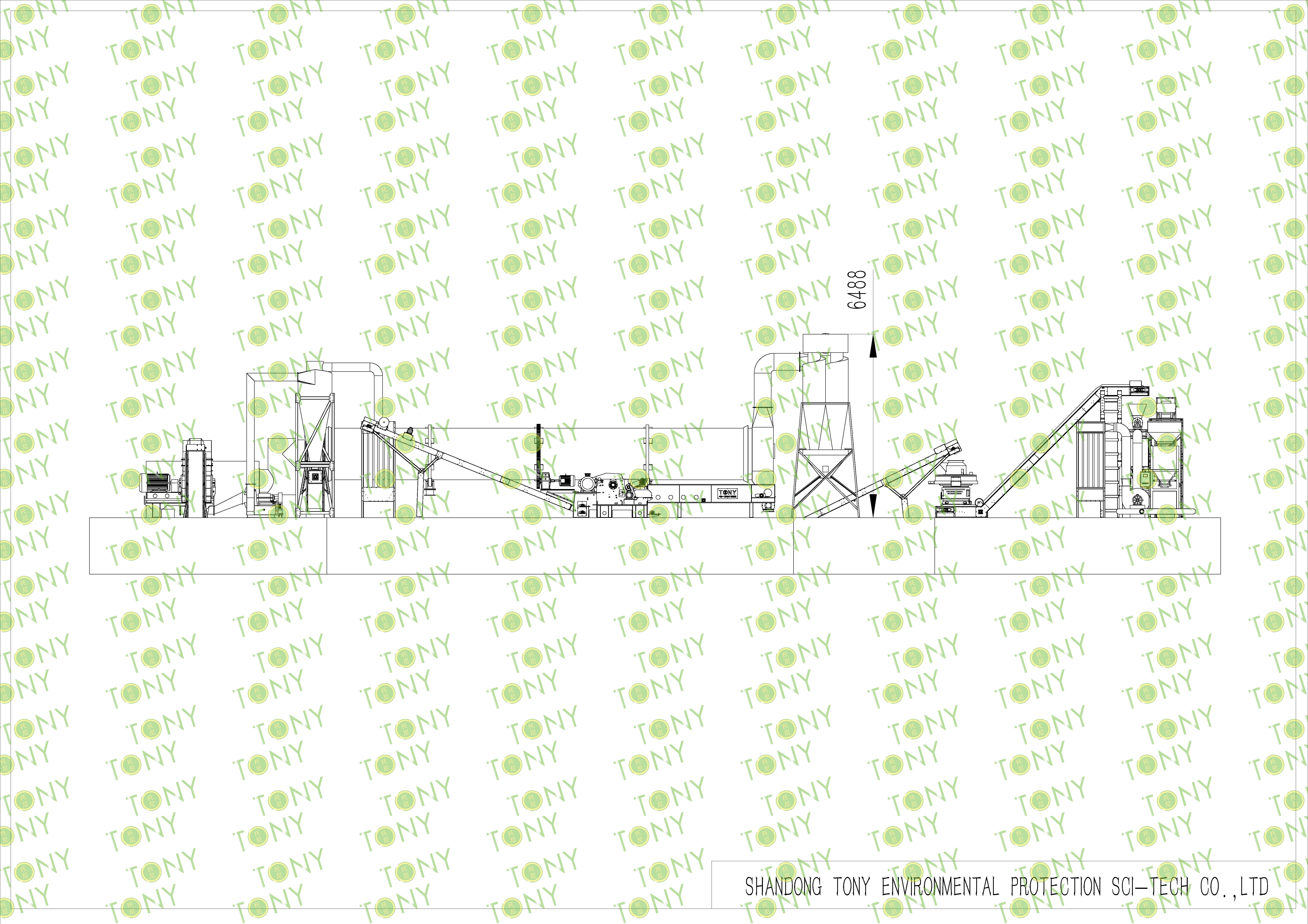
| Next, TONY Will Introduce To You All The Necessary Machinery That Will Be Used For The Whole Pellet Production Line. Some Machines Can Be Custom - Made By Customers According To Different Customers' Detailed Demands. Contact TONY For More Details, Including Quotation And Layout. | ||
 |
 |
 |
| Wood Chipper | Effective Hammer Mill | Rotary Drum Dryer |
|
1.To Grind Wood Logs φ ≤20cm Into25-55mm Wood Chips. 2.Model: TPQ216-55KW With 2 Blades*1set 3.Capacity: 4-7Ton/Hour. |
1.To Crush 25-55mm Wood Chips Into 8-14mm Sawdust. 2.Model: TFD65*75-75KW*1set 3.Capacity: 2.5-3Ton/Hour/Set |
1.To Dry The 40% Sawdust Into 10-15% Sawdust. 2.Model: THGD1.8*15*1set 3.Capacity:2.5-3Ton/Hour/Set |
 |
 |
 |
| Vertical Ring Die Sawdust Pellet Machine | Galvanized Pellets Cooler | Semi-automatic Packing Machine |
|
1.To Press Dry Sawdust Into 6-8mm Biomass Pellets 2.Model: TYJ760-III-160KW*1 Set 3.Capacity:2.5-3Ton/Hour/Set 4.New 304SS Type |
1.To Cool Pellets From 80-90℃ Into 20-30℃ 2.Model: TCN-2.5*1set 3.Capacity:2.5-3Ton/Hour |
1.To Pack Pellets Into 15-50KG/Bags. 2.Model: TBF-50*1Set 3.Capacity: 2.5-3Ton/Hour |



1.Wood Chipping Process
A.This process is mainly used to grind the wood logs whose diamater is under 20cm into wood chips with size 25-55mm. The finish wood chips size can be adjustable by changing different sizes of screeners and adding flying knives inside the wood chipper.
B..TONY Brand TPQ216 model with 2 flying blades type:
Main Parts:
(1)TONY's Wood Chipper.
(2)Feed And Discharge Belt Frequency Control To Prevent Card Material
(3)Hydraulic System Control Can Be Used For Thicker Materials
(4)Electronic Control System Allows The Equipment To Be Used Normally
Contact Tony For More Details With Quotation

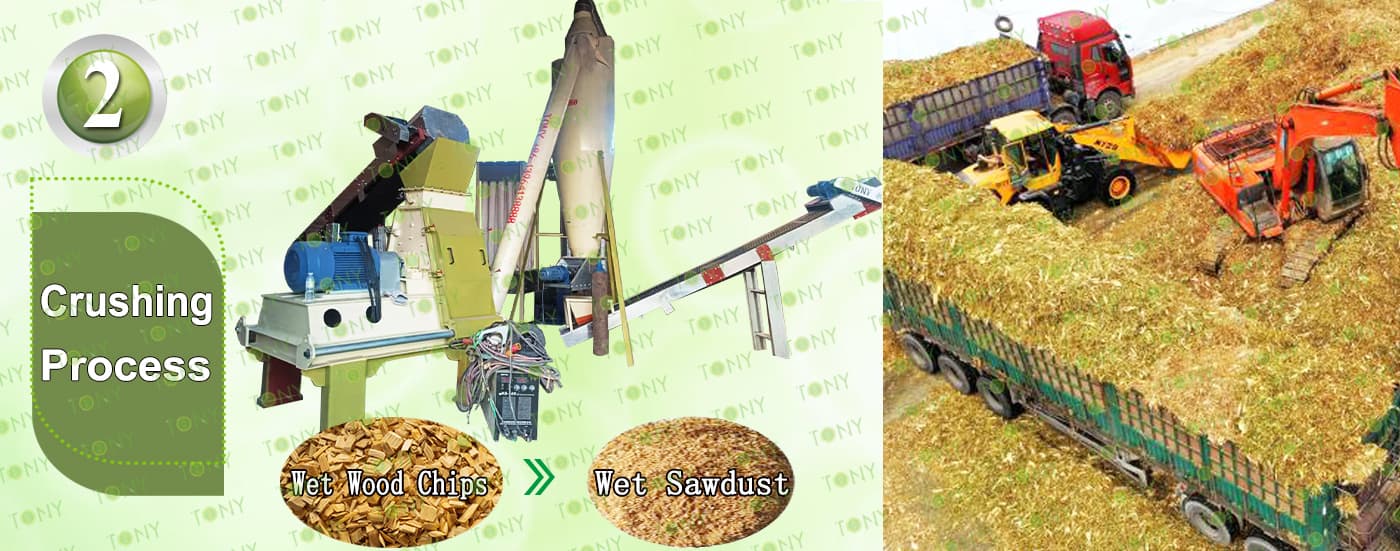
2.Wood Chips Fine Crushing Process:
A.This process is mainly used to crush 25-55mm wood chips into 8-14mm sawdust.
B.Capacity:2.5-3Ton/Hour.
C.TONY Effective hammer mill TFD65*75-75KW
Main Parts:
(1)TONY Effective hammer mill.
(2)Galvanized Dust Collector.
(3)Sawdust Transportation Fan Blower.
(4)Cyclone With Airlock.
(5)Electrical Cabinets.


3.Sawdust Drying Process:
A.This process is mainly used to dry the sawdust from 40% to 10-15%.
B.Capacity:2.5-3Ton/Hour.
C.TONY use 1set of 1.8*15m rotary drum dryer for this process, TONY hot blast stove is made of firebrick pan, shell with H steel plate as the frame. There are 3 layers of fire blocking device inside, which can effectively prevent the fire from entering the tumble dryer.Customers can choose to use waste wood, biomass pellets, natural gas, etc. as fuel for the hot air furnace
TONY dryer use spiral tube material, and is not easy to deform.
Unlike other manufacturers with iron plate splicing welding, very easy to deformation.
Main Parts:
(1)TONY's Rotary Drum Dryer Main Body. (Reducers With Motors and Pips.)
(2)TONY's Hot Stove.
(3)Fan Blower+Cyclone With Airlock.


4.Pelletizing Process:
A.This process is mainly used to to product pellets into φ6-8mm.
B.Capacity:2.5-3Ton/Hour.
C.TONY Brand Vertical Ring Die Pellet Machine TYJ760-III-160KW
Main Parts:
(1)TONY's new Vertical Ring Die Pellet Machine.
(2)Cyclone And Bags Dust Collectors.
(3)Automatic Lubrication System.
(4)Electrical Cabinets.
You can chose TONY new type SS304 pellet machine

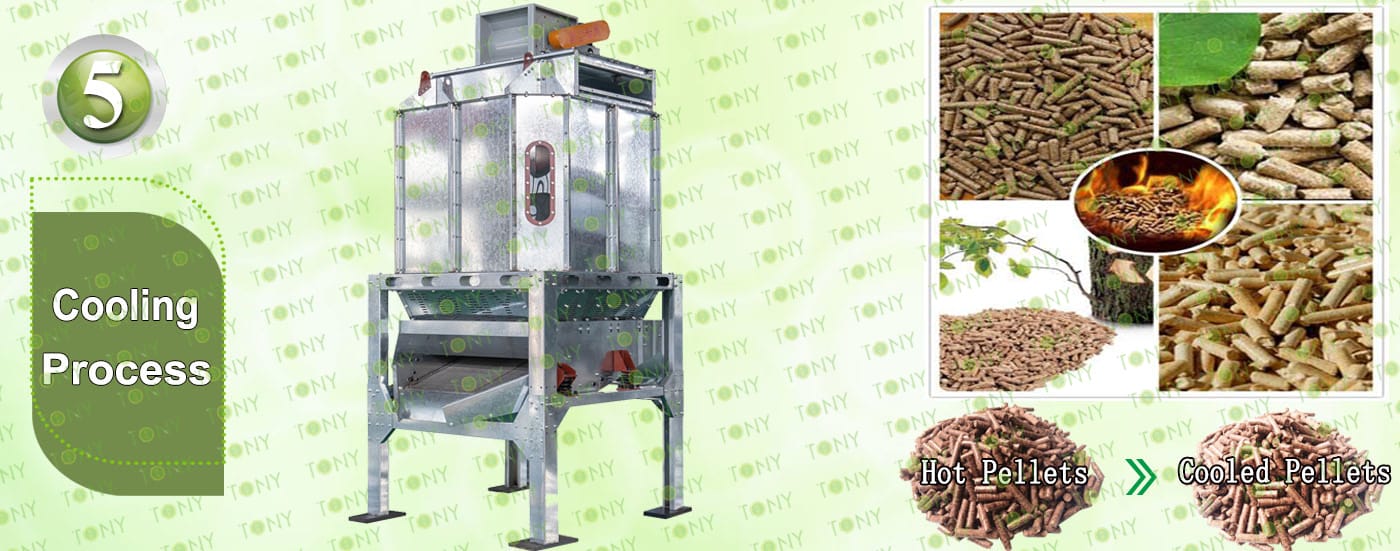
5.Cooling Process:
A.This process is mainly used to cool pellets from 80-90℃ to 20-30℃
B.1Set Of TONY Galvanized Cooler Seperator
Main Parts:
(1)TONY's new Galvanized Cooler Seperator With Vibrating Screen.
(2)Cyclone And Bags Dust Collectors.
(3) Fan Blower.
(4)Connect Pipes.

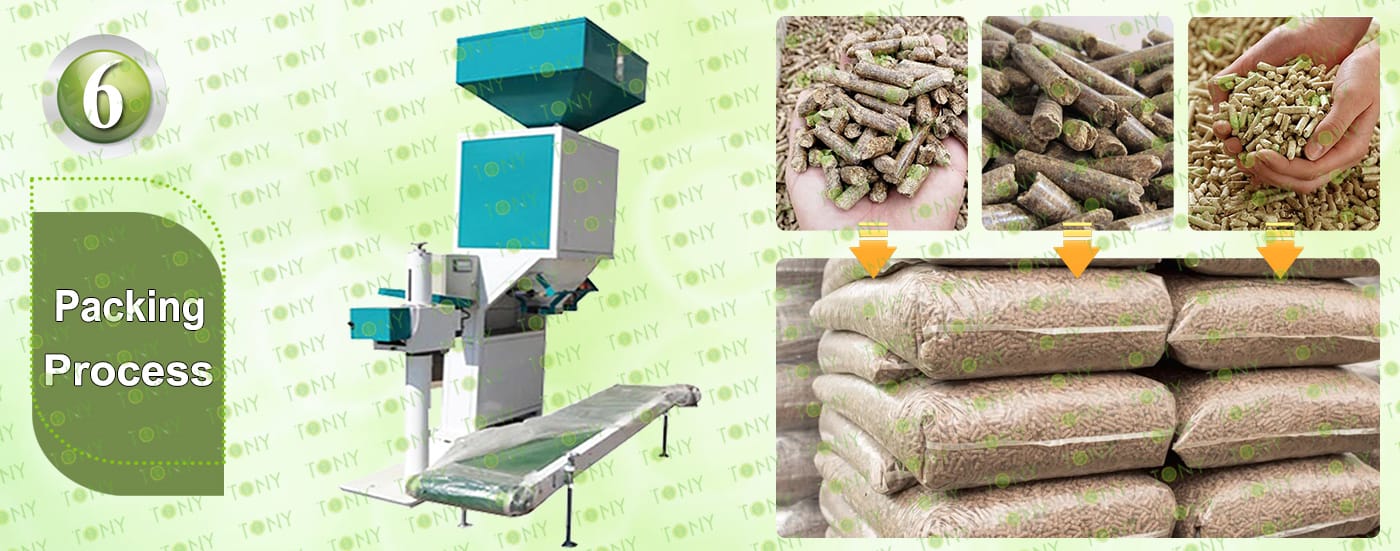
6.Packing Process:
A.This process is mainly used to pack pellets into 15-50KG/Bags.
B.1 Set of TONY Semi-Automatic Dual Packing Machine.
Main Parts:
(1)TONY Semi-Automatic Packing Machine.
(2)Sew Machine, Buyer Can Also Choose Hot Seal Machine For Chosen,To Confirm With Tony For The Price Difference.
(3)Bags Transportation Conveyors.
(4)Feeding Inlet Silo.
(5)Electrical Cabinets.

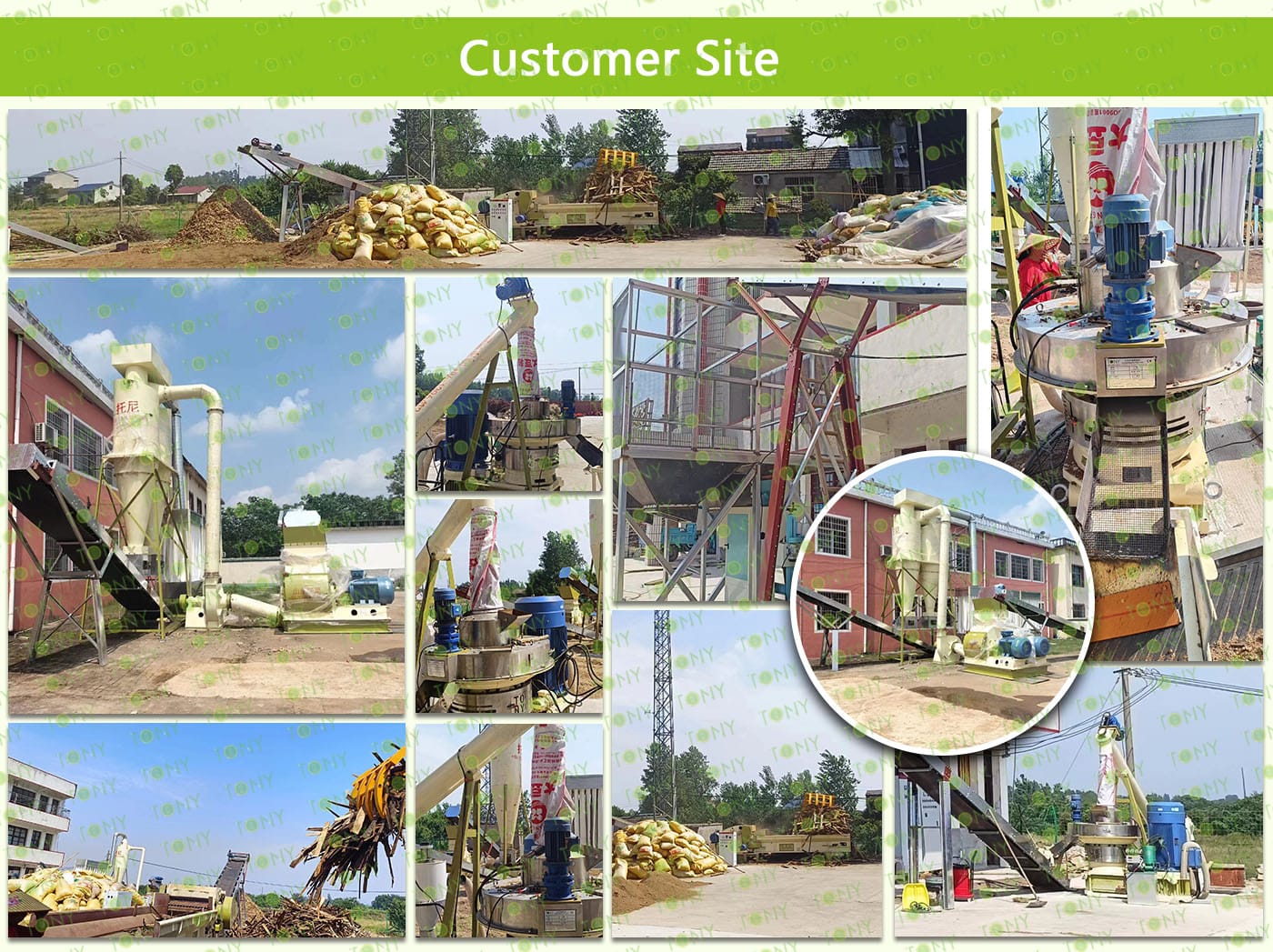

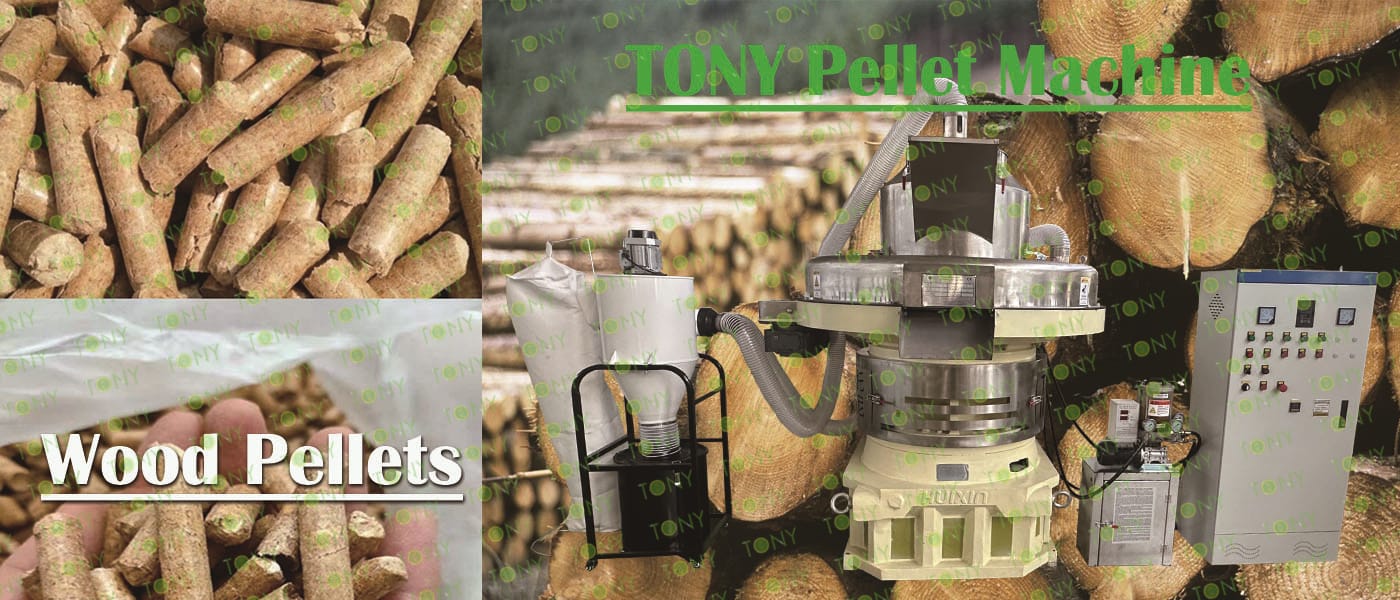
1.Significant Economic Benefits:
The selling price of biomass pellets is relatively high, but after deducting equipment depreciation, factory rental, transportation costs, and taxes, the monthly net profit is substantial.
2.Mature and Stable Technology:
Biomass pellet production technology is relatively mature. The entire production line adopts a modular design, supporting automated feeding, crushing, drying, pelletizing, cooling, and packaging, reducing manual labor. The core pelletizer can operate continuously for over 12 hours without clogging, achieving a pelletizing rate of over 98%. By optimizing the compression ratio and power matching, power consumption per ton is less than 55 kWh, saving over 15% energy compared to traditional equipment.
3.Outstanding Environmental Advantages:
Biomass pellets produce low carbon dioxide emissions during combustion, essentially achieving zero emissions. They also contain very low levels of sulfur oxides, nitrogen oxides, and dust, helping to mitigate the greenhouse effect, improve air quality, reduce environmental pollution, and meet environmental requirements.
4.Easy Storage and Transportation:
After compression molding, biomass pellets have a higher density and a more regular shape, making them easier to store and transport. This reduces storage and transportation costs, improves the efficiency of biomass energy, and enables their application in a wider range of regions.

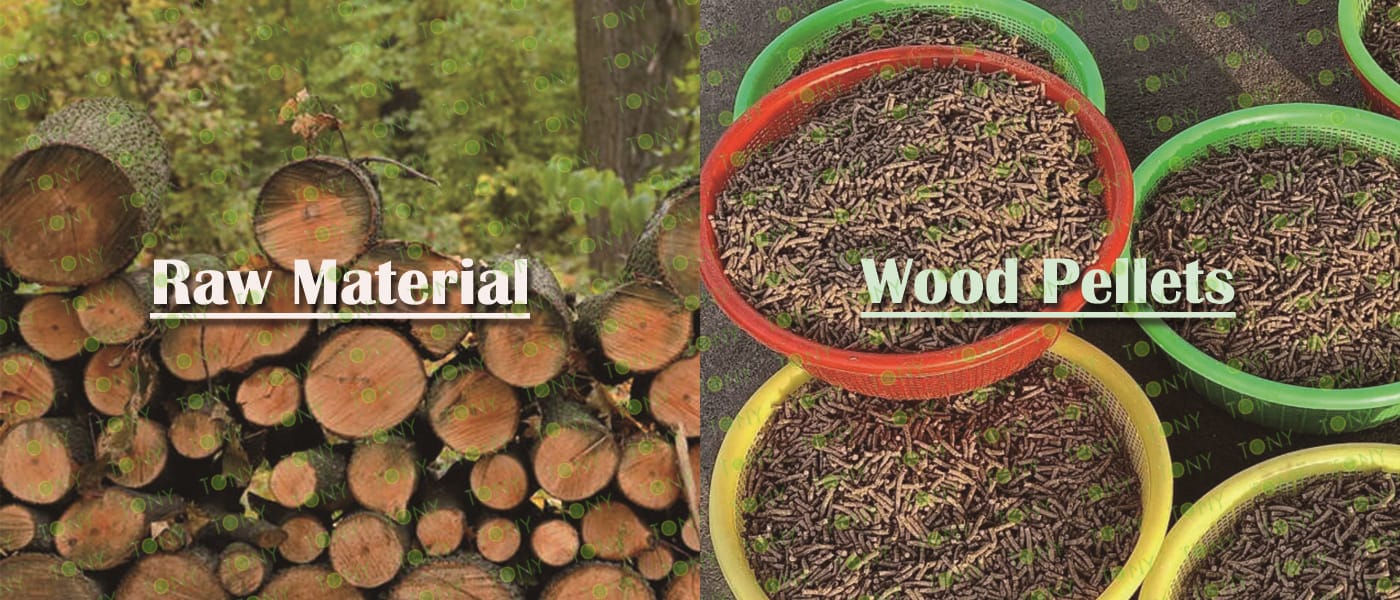
Wood pellets are standardized biomass fuels made from wood processing waste (such as wood chips, sawdust, shavings, and branches) that are crushed, dried, and compressed.
They have stable physical properties.
They have a regular shape: most pellets are cylindrical, 6-12mm in diameter and 20-50mm in length, with a density of 0.8-1.2g/cm³. They are hard and resistant to breakage, making them easy to store and transport.
They have a low moisture content: They undergo a drying process before molding, typically keeping the moisture content at 10%-15%. This reduces charring during combustion and ensures stable thermal efficiency.
Their composition and combustion characteristics are tailored to energy needs.
They are primarily composed of lignocellulose, which contains approximately 45%-50% carbon. They have a high calorific value (typically 4200-4800 kcal/kg, similar to medium-quality coal) and burn efficiently.
They have an extremely low sulfur content (typically <0.05%) and low nitrogen content. Pollutants such as SO₂ and NOₓ produced during combustion are far lower than those produced by coal, meeting environmental standards.
The raw materials are widely available and renewable.
The raw materials are wood processing waste (such as scraps from furniture and panel mills) and forestry waste (such as pruned branches and fallen leaves). This represents a "waste-to-treasure" resource recycling effort, without requiring additional arable land or forest resources.





2025 Tony Machinery - All Rights Reserved. Map